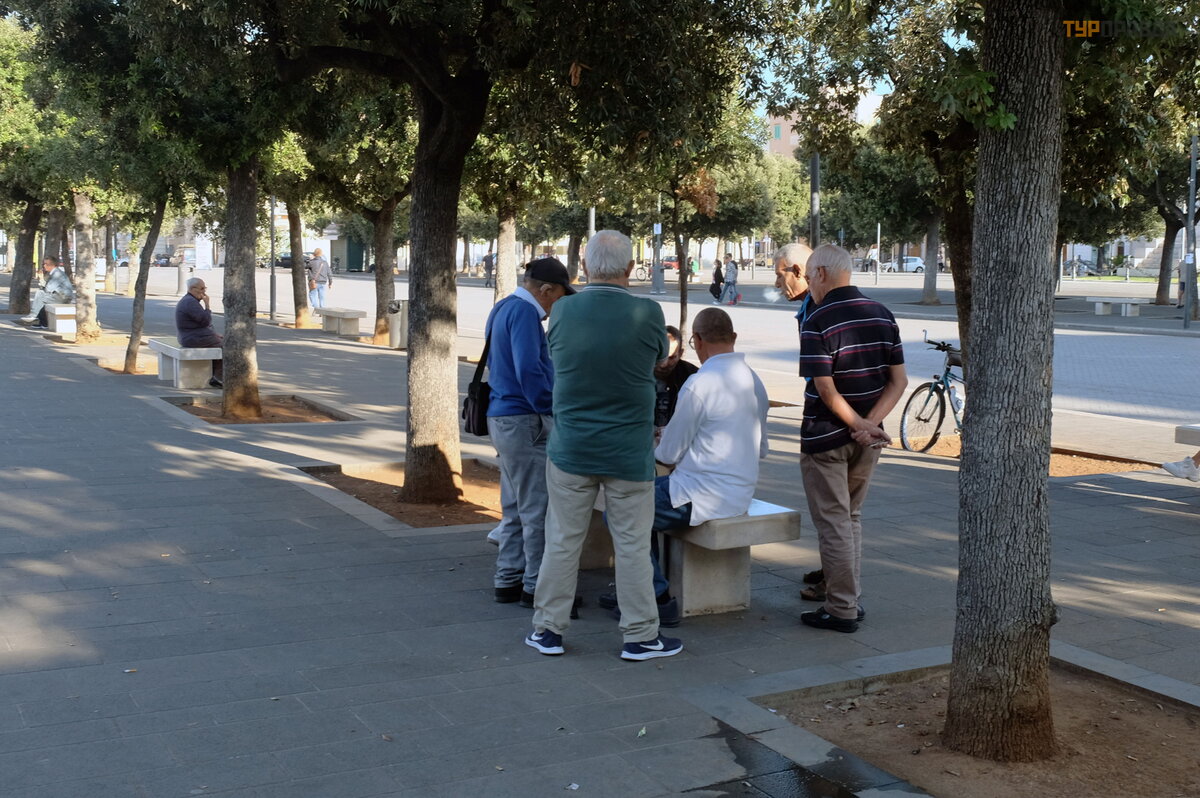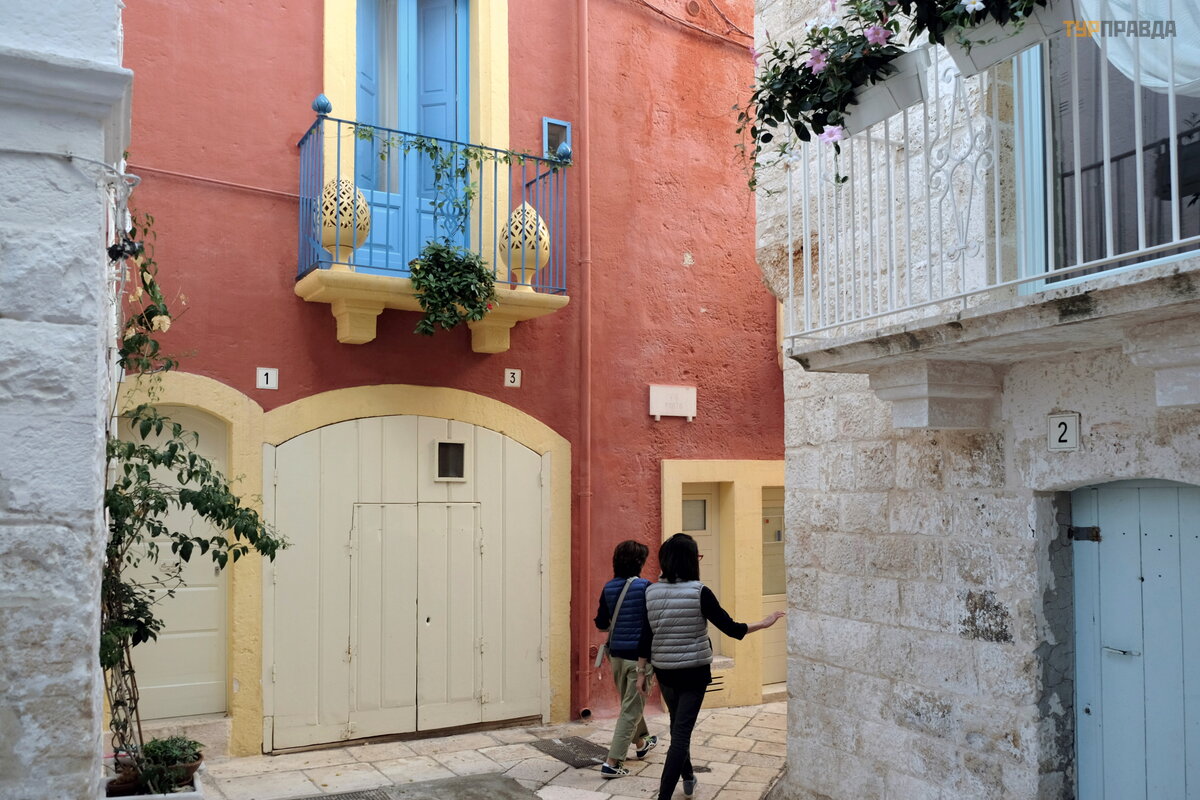Puglia and a bit of Rome. Part 2. Monopoli and Polignano a Mare

To be continued. Start here >>>
On the second day we visited the cities of Monopoli and Polignano a Mare. These two cities are practically next to each other, just one railway station from each other. Therefore, it is reasonable to combine their inspection in one day.
It must be said that from Bari towards Lecce, where these cities are located, electric trains go much less frequently than towards Trani. It takes about an hour to get to Monopoli.
The Monopoli was founded by the Greeks in 545 BC. e. Monopoli is a fairly large city by the standards of Puglia - about 50 thousand inhabitants live in it.
On the way to the port, you will pass the largest square of the city of Vittorio Emanuele II (Piazza Vittorio Emanuele II) - approximately 100 by 100 meters.
There is a monument to the fallen soldiers on it:
Playing cards in the shade of trees:
Immediately behind this square is another one - Fountain Square (Piazza Largo Fontanelle), which already borders the sea and is the border between the Old and New Towns. There is a fountain with funny octopuses on the square:
The city is similar to many seaside towns in Puglia: from the station, the road goes through modern buildings, then the Old Town and the port.
Moving towards the sea along the streets of the Old Town:
The embankment is the upper part of the defensive wall, in the center of which is the Tower of Santa Maria, also known as the "cannon" fortress, named after the Spanish king Charles V . It was built at the beginning of the 16th century, the fortress served as a prison until 1969, admission is free,
but there was already a break for a siesta.
On the wall of the fortress, you can see a memorial plaque in memory of the shipwreck that the Greek ship Heleanna suffered in 1971 near Monopoli.
Beautiful views of the port area:
Small but picturesque embankment:
A wall along the sea. . .
. . . where the ancient cannons are located.
Because we left Bari a little late, we got to the siesta when the Cathedral was closed.
The Church of San Domenico (Resurrection) (Chiesa San Domenico) is also closed for a siesta.
In order not to waste time, we decided to swim and have lunch. Near the castle there is a small area where you can swim. The beach may not be the best, but it is enough to rest here. Clear sea, water +23.
After swimming, we had lunch at the seaside restaurant of the Gallo Nero chain, not bad, but far from Neapolitan pizza.
After lunch we went to the Cathedral.
The first Cathedral was built in the Romanesque style, and later in the 18th century it was rebuilt in the Baroque style.
In the cathedral there is a miraculous icon of the Most Holy Theotokos of Madiya, the patroness of the city,
kept here in the chapel above the apse. According to legend, she sailed to Monopoli in 1117.
The interior of the cathedral is from the 18th century, entirely in the Baroque style, unfortunately, nothing remains of the original 12th century.
The bell tower of the Cathedral - it is six-tiered, attached to the cathedral in the 17th century, and its height is 61 meters.
Next to the Cathedral on the square, there is a wall built in the 18th century, 33 meters high, onto which ten statues of the 16th century were transferred from the old Romanesque cathedral. The wall was built to protect against strong sea winds.
Let's go back past Garibaldi Square with the clock tower.
At this point, we decided that it was time to move to Polignano a Mare. Having reached the station, after 10 minutes we reached this picturesque town.
This is a very popular place among tourists.
There are only 17 thousand inhabitants in all of Polignano, and therefore the historical center is generally tiny. We're heading there.
The city is located on sheer cliffs, convenient viewing platforms above the so-called sea. "balconies" with beautiful sea views.
The main church of the city of 1295, consecrated in honor of the Assumption of the Virgin (Chiesa Madre di Santa Maria Assuanta), in the small square of King Vittorio Emanuele II.
A very popular place is a city beach between two rocks with a stream, through the bed of which an ancient Roman aqueduct bridge is thrown. Usually the beach is full of people, but it was already evening and there were very few people.
On the embankment there is a monument to the famous fellow countryman, singer Domenico Modugno, who sings the most famous song Volare - to fly.
The stairs lead down to a rocky plateau with some of the most spectacular views in Polignano a Mare.
We also wandered around the picturesque corners of the Old Town:
The day turned out to be eventful, there were many impressions, we were already tired and we went to our place in Bari.
Continued here >>>



































































































I'm not just amazed! I'm just completely broken. But also happy as an elephant!
1 - Super post about visiting Lviv.
2 - I had no idea what a open-air museum was and what it was like, and even in Lviv (I went to throw my face in the manure)
3 - I still had plans for next time :-) I wish a lot of snow
I'm just wildly in love with Lviv :-) I would go there every day ... This fall I took my family there. As we walked well, then rested ... And drank wine on the Old Jewish, and took with him half a liter of Thracian. MEGA! thanks for the report !!!
Я не просто вражена! я просто дощента розбита. Але й щаслива як слон!
1 - Супер допис про відвідини Львова.
2 - Я поняття не мала що таке скансен і щл воно таке, та ще й у Львові (пішла кидатися мордою у гній)
3 - у мене таки з'явилися плани наступного разу :-) бажаю багато багато снігу
Я просто дико влюблена у Львів :-) Я б туди щодня... Цієї осені відвезла туди сімю. Як ми добре погуляли, потім і відпочили... І напилися вина на Староєврейській, і взяли з собою півлітри Фракійського. МЕГА! дякую за звіт !!!
Murmu, thank you very much for your kind words! That Lviv really does with us whatever it wants. And if we fell in love with him once - it's forever. So I wish you new good trips to this magical city, and new divinations, and new photos. And new dreams come true. About him. About Lviv. Because he is alone. Warm. Impressive. Sensitive. Our.
Murmu, красно дякую на доброму слові! Той Львів справді робить із нами все, що захоче. І вже якщо ми одного разу влюбились у нього – то це назавжди. Тож і Вам бажаю нових гарних подорожей до цього чарівного міста, і нових ворожень, і нових світлин. І нових мрій, що збуваються. Про нього. Про Львів. Бо він один такий. Теплий. Вражаючий. Чутливий. Наш.
It is also surprisingly pleasant and touching to receive such a comment from a person who has seen both Florence and Buenos Aires... :-)
А ещё удивительно приятно и трогательно получить такой комментарий от человека, повидавшего и Флоренцию, и Буэнос-Айрес... :-)
oh well :-))) you understand that this is a completely different thing ... there is still breathing, there are tears dripping in the cathedral, there in the park every leaf you want to kiss, there you sing along to a street musician, and go to the smell of coffee and chocolate like cat for valerian ... :-) .. I love Lviv so much that we lack words :-))
ой да ладно :-))) ви ж розумієте, що це ЗОВСІМ інше ... там дихається яче, там у соборі сльози капають, там у парку кожен листочок хочеться цілувати, там підспівуєш вуличному музикантові, і йдеш на запах кави та шоколаду як кіт за валеріаною... :-).. Я так люблю той Львів що ми бракує слів :-))
Yes. This is completely different. This is a boy in a rastaman beret, playing in the park on the snot "Chornobrivtsi shone mother ...". This is a street quartet near the chapel of the Boims, they look like students of the conservatory, who in real life turned out to be musicians from Ukraine, Belgium, the Netherlands and from somewhere else, moreover, famous musicians who recorded an album in one of these countries, and stopped by a Lvov colleague in Lviv for a couple of days. guests, and for the sake of pleasure, those who went out to play music on the square. This is a crowd near the Opera at the festival of ice sculptures, singing in unison "Chubariki-chubchiki ...". These are people. This is kava. This is cheesecake. It's the spirit, the atmosphere. I love Lviv. And I always dream of returning as soon as possible.
Да. Это совсем другое. Это парнишка в растамановском беретике, играющий в парке на сопiлцi "Чорнобривцi посiяла мати...". Это уличный квартет возле часовни Боимов, по виду-студенты консерватории, в реале оказавшиеся музыкантами из Украины, Бельгии, Нидерландов и ещё откуда-то, причём музыкантами знаменитыми, записавшими в одной из этих стран альбом, и заехавшими на пару дней к львовской коллеге в гости, и ради удовольствия вышедшими помузицировать на площадь. Это толпа возле Оперного на фестивале ледовых скульптур, хором распевающая "Чубарики-чубчики...". Это люди. Это кава. Это сырник. Это дух, атмосфера. Обожаю Львов. И всегда мечтаю поскорее вернуться.